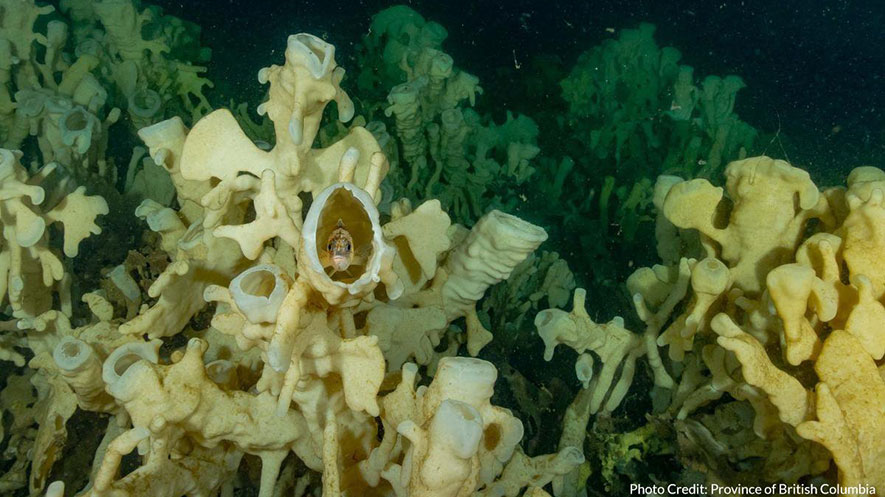During a February 2017 visit to Vancouver, Dominic LeBlanc, Canada’s Minister of Fisheries, Oceans and the Canadian Coast Guard, announced a suite of initiatives, including the establishment of the new Hecate Strait and Queen Charlotte Sound Glass Sponge Reefs Marine Protected Area, which will protect large colonies of unique glass sponges estimated to be 9000 years old.
The reefs provide refuge, habitat and nursing grounds for many aquatic species such as rockfish, finfish and shellfish. The designation of this Marine Protected Area is a step forward in Canada’s plan to protecting 5% of its marine and coastal areas by 2017 and 10% by 2020.
In addition, the Minister signed, along with provinces, territories, Indigenous peoples and stakeholders, the Pacific North Coast Integrated Management Area (PNCIMA) Plan. This Plan will help protect the health of the North Pacific Coast by setting out a framework to manage the marine activities and resources in that area.
The four reefs in the MPA were the first discovered living examples of glass sponge reefs, thought to be extinct worldwide, that existed during the Jurassic period. The discovery of four major glass sponge reefs in 1987 by the Geological Survey of Canada sparked interest in these delicate and vulnerable marine animals. Thought to be extinct worldwide, the four reefs in Hecate Strait were determined to be over 9000 years old. They are considered the largest living example of glass sponge reefs that were abundant during the Jurassic period.
The reefs cover a total area of about 1000 km2. They are located at depths of 140 to 240 meters below the surface, with the largest being 35 km long, 15 km wide and 25 m tall.
These sponges are fragile, with skeletons made of silica, or glass. Sponges are easily broken on impact, and can be smothered by increased sediment. The ocean conditions necessary to allow such large reefs to develop are rare, and the fragility of the reefs make them vulnerable to damage from human activity. Each sponge may live for over 200 years, and the slow growth and vulnerability of the sponges suggests that recovery from damage may take tens to several hundreds of years. If the skeletons of dead sponges are buried or destroyed, new sponges cannot grow to add stability to the reef.
The sponge reefs provide refuge, habitat, and nursery grounds for aquatic species, including commercially important rockfish and other finfish and shellfish species.
The MPA is composed of three individual areas known as the Northern Reef, the Central Reefs, and the Southern Reef. Together these three areas cover approximately 2,410 square kilometers.
“With these initiatives, as well as other initiatives under the $1.5 billion Oceans Protection Plan, I know that we will make great strides in safeguarding our coasts for future generations,” said LeBlanc.
Protecting marine mammals
Under the Oceans Protection Plan, the Canadian government is taking action to better understand and address the cumulative effects of shipping on marine mammals.
While speaking to stakeholders at the Vancouver Aquarium, the Minister announced that Fisheries and Oceans Canada (DFO) will work with a coalition of partners to integrate underwater acoustic data to enhance knowledge on the impacts of noise on marine mammals and make better decisions on how to mitigate these impacts. The Department is currently concluding an agreement with the Vancouver Fraser Port Authority to further support this project through the acquisition of hydrophones and other acoustic monitoring technology and systems.
The Minister also announced that Fisheries and Oceans Canada has launched a science-based review of the effectiveness of current management and recovery actions under way for the southern resident killer whale, the North Atlantic right whale and the St. Lawrence estuary beluga. The science-based review will be completed during the summer of 2017 and will identify key additional measures and priorities for new or enhanced actions.
Monitoring pollution in our oceans
At the Vancouver Aquarium, the Minister also announced over $1 million in support for two new research projects to monitor contaminants and investigate their impacts in the Pacific and Arctic Oceans. Fisheries and Oceans Canada is providing $399,000 to the Vancouver Aquarium to help implement Pollution Tracker, a new science program that will help identify the sources of contaminants in British Columbia and inform policies and management decisions.
The Vancouver Aquarium is receiving a further $215,000 to study, for the first time, microplastics in the Arctic Ocean and their biological effects on marine life. An additional $520,000 in in-kind support, such as vessel use, will be provided to assist in the collection of samples.
“Pollution is a major issue for sea life and human health around the world,” said Dr. Andrew Day, Executive Director of the Vancouver Aquarium’s Coastal Ocean Research Institute. “The Government’s announcement addresses the urgent need for data on a wide range of pollutants in coastal British Columbia – including hydrocarbons, flame retardants, and heavy metals – as well the emerging issue of plastics in our oceans. This partnership will help us all understand what needs to be done to protect ocean life and human health for future generations.”
Increasing the Coast Guard’s capacity
The Minister also highlighted the Government of Canada’s commitment to enhancing the prevention and response capacity of the Canadian Coast Guard. New lifeboat stations, modern equipment, and emergency tow packages are among the measures that will be put in place under the Oceans Protection Plan. The Government of Canada will also be establishing a dedicated Primary Environmental Response Team (PERT) near Port Hardy, British Columbia.





